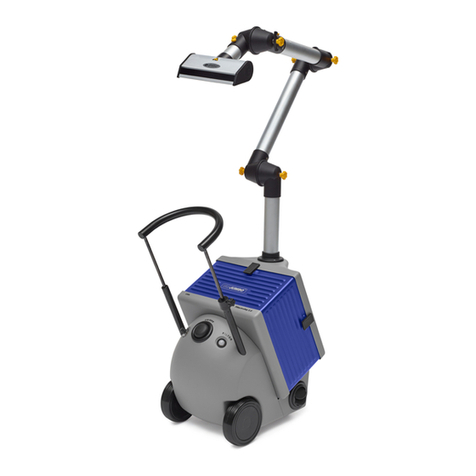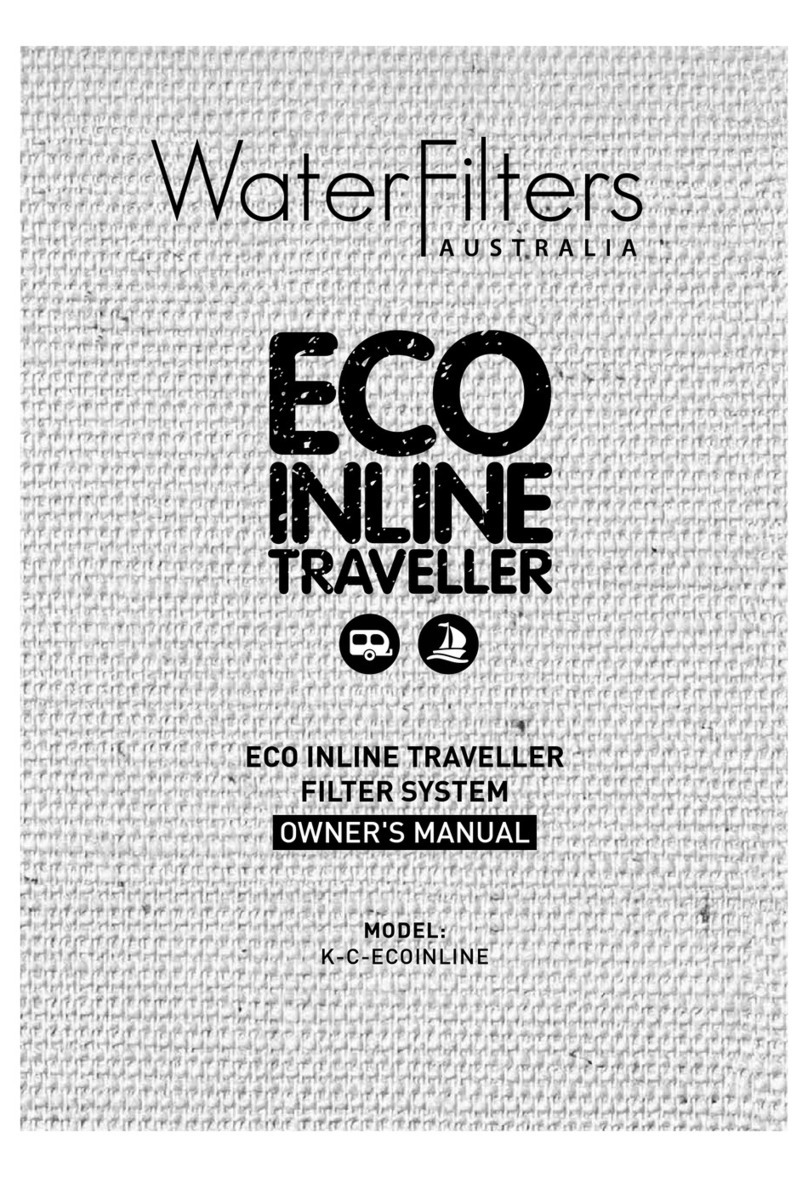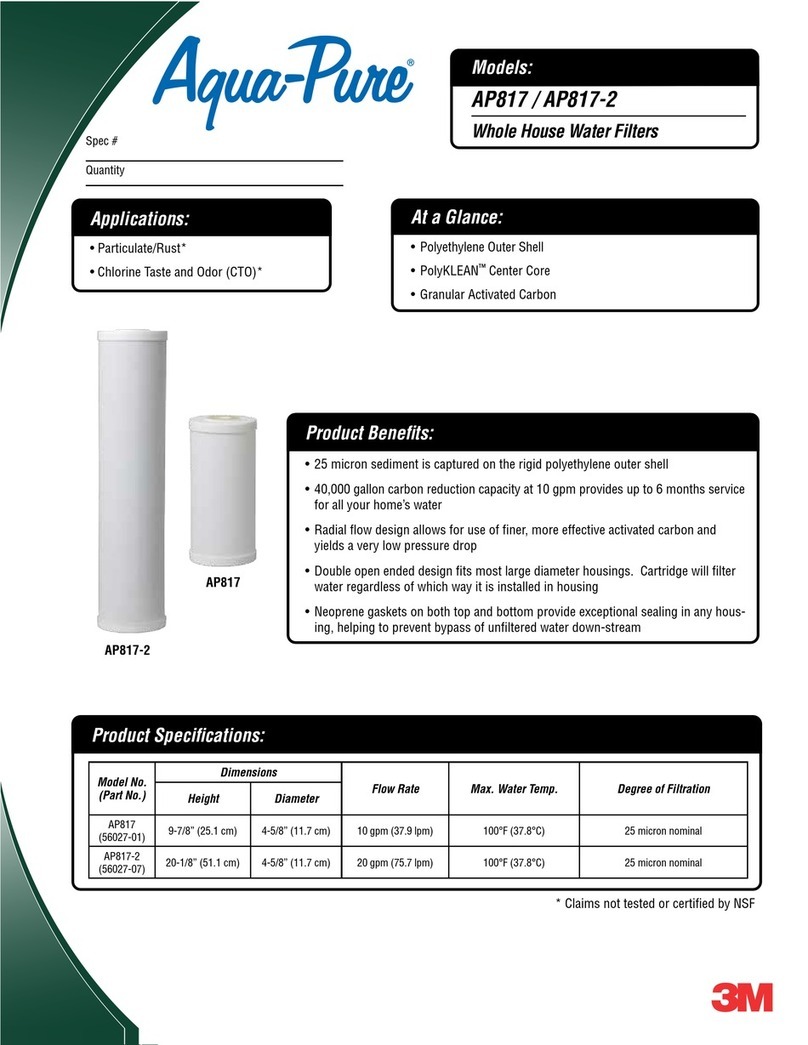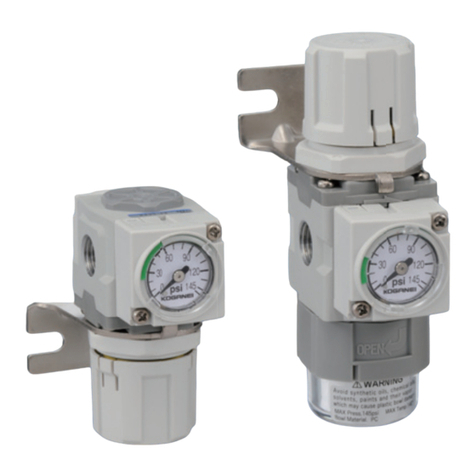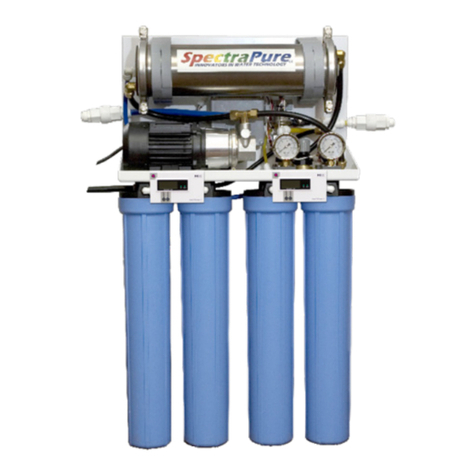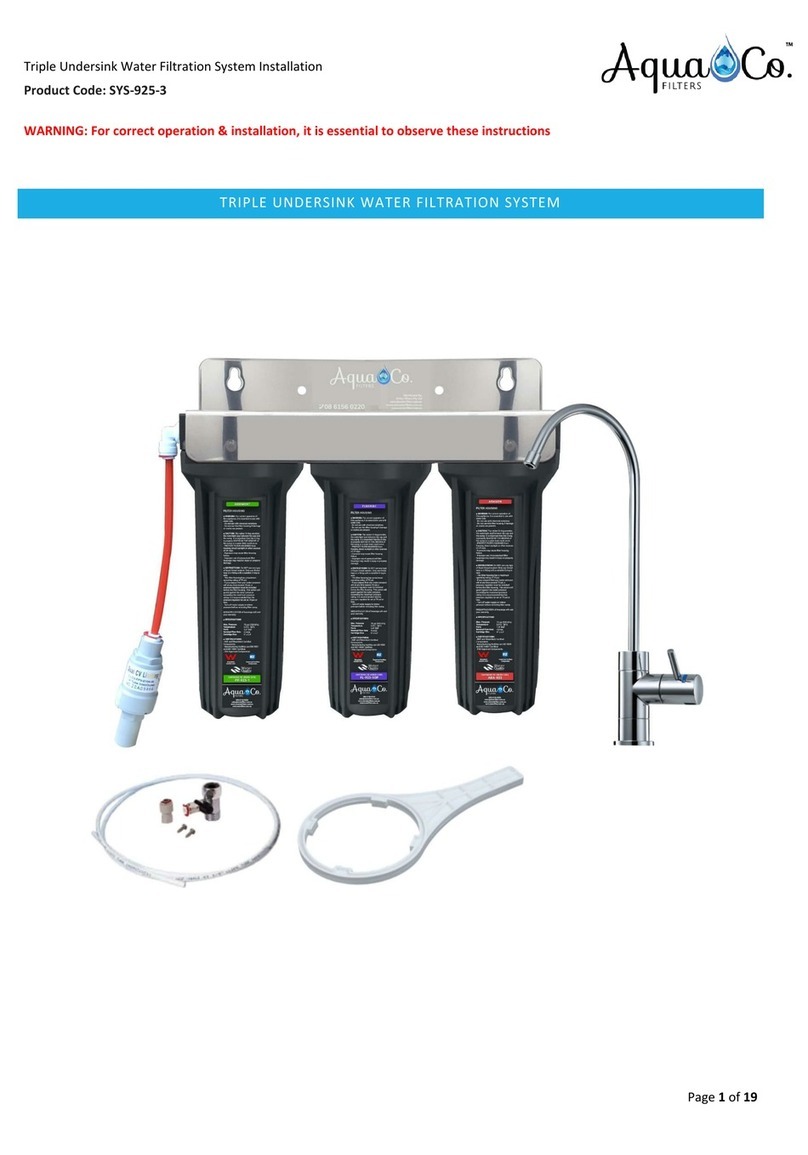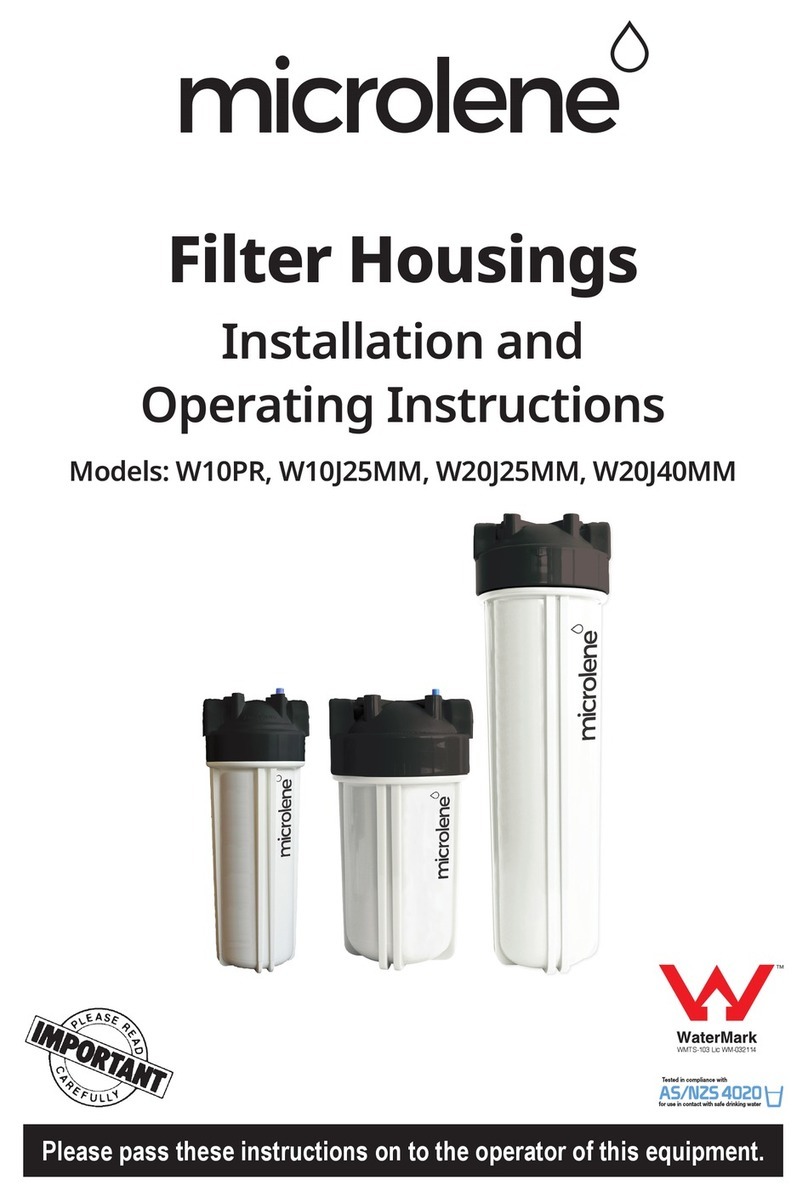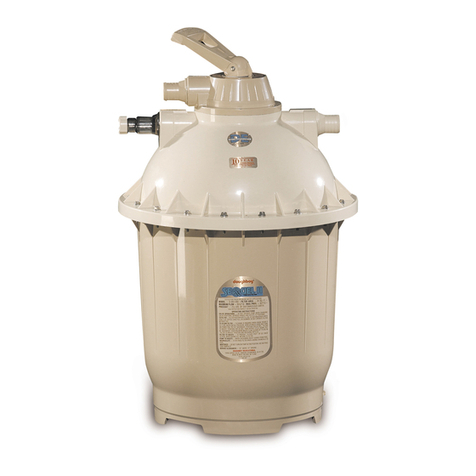DEHOUST Watermanager GWM 500 inhouse Guide

Watermanager GWM 500 inhouse
Greywater treatment for re-use of process water
Installation and commissioning manual
Valid from Firmware version: GWM 500_V 5.43
Last updated: 18.03.2019

Contents
1. Safety advice ..................................................................................................................... 1
1.1. Reference to other manuals ................................................................................................................ 1
1.2. Safety advice in these instructions ...................................................................................................... 1
1.3. General safety advice........................................................................................................................... 1
1.4. Further safety conditions..................................................................................................................... 2
1.5. Consequences and risks of non-compliance with the manual............................................................. 2
1.6. Duty of care of the operator ................................................................................................................ 2
1.7. Safety advice for maintenance, inspection and assembly work .......................................................... 2
1.8. Duty to register service water plants................................................................................................... 3
1.9. Requirements of operating personnel................................................................................................. 3
2. General information .......................................................................................................... 4
2.1. Warranty and liability .......................................................................................................................... 4
3. Description........................................................................................................................ 5
3.1. Functional description ......................................................................................................................... 5
3.2. Process water quality........................................................................................................................... 5
3.3. Technical specifications ....................................................................................................................... 6
3.4. Scope of delivery.................................................................................................................................. 6
3.5. Structure .............................................................................................................................................. 7
3.6. Intended use ........................................................................................................................................ 7
3.7. Improper use........................................................................................................................................ 8
4. Transport .......................................................................................................................... 8
5. Installation/Assembly........................................................................................................ 9
5.1. Installation room.................................................................................................................................. 9
5.2. Installation of the tanks ....................................................................................................................... 9
5.3. Connection of the coarse filter ............................................................................................................ 9
5.4. Overflow of the tanks ........................................................................................................................ 11
5.5. Air compressor and filtrate lines........................................................................................................ 12
5.6. Installation of submersible booster pump into process water storage tank ..................................... 13
5.7. Drinking water feed ........................................................................................................................... 15
5.8. Process water line .............................................................................................................................. 16
5.9. Emergency overflow due to Type AB drinking water feed ................................................................ 17
5.10. Electrical connection.......................................................................................................................... 18
5.11. Potential-free alarm output ............................................................................................................... 20
5.12. Extern alarm input ............................................................................................................................. 21

6. Commissioning ................................................................................................................ 22
6.1. System operation until commissioning.............................................................................................. 22
6.2. Step 1: commissioning to mains water –without greywater inflow ................................................. 23
6.3. Step2: commissioning to mains water with greywater inflow........................................................... 23
6.4. Step 3: commissioning to automatic-operation ................................................................................ 24
6.5. Extended periods of downtime.......................................................................................................... 25
7. Repairs............................................................................................................................ 26
7.1. Inspections ......................................................................................................................................... 26
7.2. Maintenance ...................................................................................................................................... 27
8. Errors/Troubleshooting ................................................................................................... 29
8.1. Errors displayed at the control unit ................................................................................................... 29
8.2. Pressure surges in drinking water line ............................................................................................... 29
8.3. Odours in the installation room/at the consumers ........................................................................... 29
9. Disposal .......................................................................................................................... 29
10. Declaration of Conformity............................................................................................. 30

1
1. Safety advice
For a safe and trouble-free operation of the system please pay attention to the following manuals too:
•Manual for commissioning
•Operation manual GWM
New-installation: operating manual GWM (according to valid firmware)
•Maintenance
•Exchange of BMT-membrane
filter
•Software-Update
Manual BMT-membrane filter exchange and software-update.
Instructions labelled with this symbol provide advice on technical information and tips for usage, which should
avoid any damage to the system. This symbol does not denote safety advice.
Instructions labelled with this symbol indicate that minor bodily injury or minor material damage can occur if the
precautionary measures are not heeded.
Instructions labelled with this symbol indicate that death, severe bodily injury or considerable material damage
can occur if the precautionary measures are not heeded.
This manual contains basic instructions, which should be taken into account during transportation, assembly, commissioning,
operation, maintenance, storage and disposal. The valid data, operating conditions and usage conditions specified in the tech-
nical datasheet and manual must be taken into account when using the Watermanager GWM.
This installation manual is valid only in association with the corresponding valid operation manual GWM.
After any Software-Update please consider the new corresponding operation manual for the control unit.
•Never exceed the permitted limits of use stated in the documentation with regards pressure, temperature, etc.
•Follow all the safety advice and handling instructions in this manual.
•Instructions displayed directly on the system must be heeded and must be kept in a completely legible condition. This
applies to:
−Safety advice
−Labels regarding connections
−Type plate
•Before assembly and start-up, the manual must be read by the user and the responsible specialist/operator. The manual
must always be available in the Watermanager GWM’s place of use.
•Installation and maintenance work must only be carried out by an authorised professional with suitable tools.
•The technical condition of the Watermanager GWM must be checked at regular intervals by the operator.
•Local safety and accident regulations must be complied with when operating the Watermanager GWM.
•The generally accepted rules of technology must be complied with for the assembly and operation of the appliance.
•No changes to the Watermanager GWM are permitted. Any changes will lead to any warranty claims being void.
•A defined or controlled restart of the process must be carried out after any interruption to the electricity or fluid supplies.
•The operator is responsible for complying with the local conditions that are not detailed in this manual.
1.1. Reference to other manuals
1.2. Safety advice in these instructions
1.3. General safety advice

2
As well as the safety advice listed in this manual and the proper use, the following safety conditions apply:
• Accident prevention regulations, safety and operating conditions
• Safety conditions when dealing with hazardous substances
• Valid standards and legislation, particularly the following standards: DIN EN 12056, DIN 1988, DIN 1986, DIN EN 1717, DIN
EN 806.
• Non-compliance with this manual will lead to the loss of any warranty and claims for damages.
• Non-compliance can result in the following risks:
−Danger to persons use to electrical, thermal, mechanical and chemical impacts
−Failure of important functions of the product
−Failure of instructed methods for maintenance and repairs
−Danger to the environment due to the leakage of hazardous substances
The Watermanager GWM has been designed and constructed under whilst taking into account a risk assessment and after
careful selection of the harmonised standards to be complied with and other technical specifications. This means the product
conforms to the state of technical knowledge and guarantees a maximum level of safety. But this safety can only be achieved in
operational practice if all the measures required for this are met. It is the Watermanager GWM operator’s duty of care to plan
these measures and check their execution. In particular, the operator must ensure that
•the Watermanager GWM is only used as intended.
•the Watermanager GWM is only operated in a flawless, functional state.
•the manual is always in a legible condition and available in its entirety at the Watermanager GWM’s place of use.
•only sufficiently qualified and authorised personnel assemble the Watermanager GWM, commission it, repair it and carry
out maintenance on it.
•these personnel are regularly instructed in all the relevant issues of occupational safety and environmental protection, as
well as ensuring that they have read and understood the manual and, specifically, the safety advice contained therein.
•none of the safety and warning signs attached to the Watermanager GWM are removed and that all remain in a legible
state.
•any additional risks which arise due to the specific working conditions at the place of use of the Watermanager GWM are
recognised as part of a risk assessment (in the sense of the German Occupational Safety and Health Act § 5 or the equiva-
lent legislation in the country of use).
•all additional instructions and safety advice arising from the risk assessment are complied in a user guide (in the sense of
German Work Equipment Usage Ordinance § 6 or the equivalent legislation in the country of use).
•the duct routing is dimensioned sufficiently.
•The machine may only be altered or modified with the consent of the manufacturer.
•Only use original parts or those authorised by the manufacturer. Using other parts can void your warranty for any conse-
quences resulting there from.
•Only work on the machine when it is turned off.
•The parts of the system must be at the ambient temperature.
•Ensure the inspection/maintenance procedures described in the manual are complied with exactly.
1.4. Further safety conditions
1.5. Consequences and risks of non-compliance with the manual
1.6. Duty of care of the operator
1.7. Safety advice for maintenance, inspection and assembly work

3
•Reattach or restart any safety and protection equipment immediately after work has been completed. Before restarting the
equipment, ensure the listed points for start-up have been taken into account.
•Keep any unauthorised persons (e.g. children) away from the system.
All service water plants must be registered when started up or decommissioned in the Federal Republic of Germany. Check
your duty to register in accordance with the country-specific regulations, standards and legislation concerning service water
plants.
The Watermanager GWM must only be assembled, commissioned, repaired and decommissioned by persons who have been
trained, instructed and authorised for this purpose. If necessary, training can be provided the manufacturer/supplier at the re-
quest of the operator. Training sessions for the system must only be carried out under the supervision of technical profession-
als. The relevant authorisations of personnel must be clearly specified by the operator in the form of a user guide. In addition,
special qualifications are required for the following activities:
•Work on the electrical equipment must only be carried out by trained electricians.
•Assembly, maintenance and repair work must only be carried out by qualified professionals.
The basic regulations for occupational safety and accident prevention must be heeded.
1.8. Duty to register service water plants
1.9. Requirements of operating personnel

4
2. General information
The manual is part of the specified series and its models. The manual describes the proper and safe use of the equipment in all
operating phases. The type plate states the series and size, the most important operational data and the serial number. To
maintain any warranty claims in the case of damage, the authorised dealer must be notified immediately with information of the
installation site and serial number of the machine.
The general delivery conditions and terms of sale of DEHOUST shall apply. Any warranty and liability claims for personal or
material damage are void if they can be attributed to one or more of the following causes.
•Improper use of the Watermanager GWM
•Improper assembly, commissioning, operation and maintenance of the Watermanager GWM
•Non-compliance with the instructions in the manual regarding transportation, storage, assembly, commissioning, operation,
maintenance and repair of the Watermanager GWM
•Unauthorised structural modifications to the Watermanager GWM
•Improperly executed repairs
•Disasters caused by third party exposure and forces majeures.
2.1. Warranty and liability

5
3. Description
Using BioMembranTechnologie, the Watermanager GWM treats domestic greywater from baths, showers and basins to pro-
duce high-quality process water for a second purpose as process water.
The separately collected greywater is initially relieved of any insoluble substances contained in it, such as hair, textile fluff, etc.,
using the Trident coarse filter. This coarse filter is automatically back-flushed and cleaned periodically. Subsequently, the con-
trol unit ensures all biodegradable substances contained in the water, such as shower gel, shampoo, soap, etc. are broken
down by micro-organisms in the Watermanager GWM. To do this, the greywater is to create a consistent oxygen supply for
biodegradable processes. The BMT membrane filter, the heart of the BMT unit, performs the last treatment process. By applying
a low pressure, the water is gently drawn through the filter membranes into the process water storage tank. The permanently
physical barriers of the BMT membrane filter with just a 38 nm pore width guarantees secure separation of particles, sludge,
germs and adsorbed viruses from the greywater: the result is absolutely clear, odour-neutral and germ-free process water. The
cleaned greywater can be stored for a long time and reused with no hygienic hesitations due to the very low nutrient content
(biological cleaning) and virtually undetectable remaining biomass (ultrafiltration). If there is no process water available, the
Watermanager GWM automatically switches to drinking water operation. If needed, drinking water is automatically feed into the
process water storage tank in accordance with DIN EN 1717 (AB).
All unit processes are micro-electronically monitored by the central control unit and managed in a fully-automated manner.
Faults are shown by a visual or acoustic message and can be sent by SMS or email to a mobile telephone or central control
room via an optional GSM modem (available as an optional accessory). It is also possible to connect a potential-free alarm
contact to a standard connection.
The process water does not have the quality of drinking water, but is many times below the hygienic, microbiological re-
quirements of the British Standard 8525-1 for greywater usage, the EU Bathing Water Directive 2006/7/EC (2006) and the
requirements of Irrigation Classification 2 (public parks, school sports facilities) in accordance with DIN 19650 (1999). This high-
quality process water can be used without any hygienic qualms for any purposes in the field of process water usage.
Table 1: Outflow qualities of process water after treatment by Watermanager GWM
Parameter
Outflow quality*
Biological oxygen demand
(BOD5)
< 5 mg/L
Chemical oxygen demand
(CSB)
< 30 mg/L
TS (dry solids)
< 1 mg/L
Turbidity
1 NTU
Eschericha coli
0 cfu/100ml
Total coliforms
< 10 cfu/100ml
* greywater feed quality from showers, bath tubs, washbasins as per fbr information sheet H201 (2005) Table 1.
3.1. Functional description
3.2. Process water quality

6
Table 2:Technical details of the standard Watermanager GWM*
Description
GWM 500 with booster pump
GWM 500 without booster pump
Item number
813330
813335
Treatment capacity [litre/day]
500
Greywater inlet / overflow
DN 100
Process water overflow
DN 100
Greywater storage tank [litre]
200
Process water storage tank [litre]
600
Connection of coarse filter back-
flush
1/2” female
Drinking water pipe connection
½” female (max. 8,9 m³/h at 5 bar)
Process water pipe connection
(depending on pressure increase)
1” male
1 ½” female
Flow pressure of coarse filter back-
flush / drinking water feed
min. 1 bar; max. 5 bar
Ambient temperature
15°C to 25°C
Mains voltage
230 V AC, 50 Hz, 16 A
Power consumption without pres-
sure increase [watt]
200
Empty weight [kg]
110
Booster pump
Delivery rate
Delivery height
Connection
Power consumption
5,5 m³/h
48 m
1” male
1.100 / 230 V
-
*All shown details may vary depending to specific project details.
Pre-assembled Watermanager GWM 500, consisting of:
•Trident coarse filter
•Greywater buffer tank/BMT unit
•Process water storage tank with integrated drinking water feed facility as per DIN EN 1717 type AB
•Control unit
•Air compressor with wall bracket
•Plastic bag with activated carbon and dried bacteria culture for initial inoculation
•Assembly accessories
•Hose connectors
•Documentation folder
oOperating instructions
oSpecific set-up diagram
oSafety data sheet activated carbon/dry bacteria
3.3. Technical specifications
3.4. Scope of delivery

7
Version with submerged booster pump includes:
•Submersible booster pump
•HDPE pipe with quick-connector
Figure 1: Principle structure of the Watermanager GWM
The actual system may deviate from the basic set-up. Please see specific set-up diagram!
The Watermanager GWM must only be operated in those fields of use described in this manual. Risks for people, surrounding
systems and the environment may arise if the Watermanager GWM is used improperly.
•Only operate the Watermanager GWM in a technically flawless state.
•Do not operate the Watermanager GWM in a partially assembled state.
•The Watermanager GWM is used to treat slightly contaminated domestic wastewater from showers, bathtubs and washba-
sins.
•The Watermanager GWM may be operated up to a maximum water temperature of 40°C.
•Heed the information concerning maximum flow rates and pressures (see chapter 3.2) (avoidance of overheating, damage
to mechanical seals, damage to cavitations, storage damage, ...).
3.5. Structure
3.6. Intended use

8
•Do not restrict the drinking water feed of the Watermanager GWM on the input side (avoidance of cavitation damage, dry
running of pressure booster).
•Agree alternative operational modes, if not stated in the documentation, with the manufacturer.
The Watermanager GWM is not intended for outdoor use. Influences of temperature, light and moisture can lead to functional
disturbances and damage to the equipment.
•Do not use the Watermanager GWM outside.
•Only use the Watermanager GWM as intended.
•Watermanager GWM is not permitted for cleaning of
oIndustrial wastewater
oExtremely contaminated wastewater from kitchens
oWastewater containing faeces
oWastewater from washing machines
oWastewater from dishwashers
oDyed wastewater (e.g. paint residue, textile and hair dye)
oContaminated wastewater (e.g. concentrated lyes and acids, medical mud baths, pharmaceuticals/medication,
foaming water additives, silicones, resins, solvents, colouring agents, flocculants)
•Do not fill the media utilities of the system with flammable media.
•Do not put the casing and tank under mechanical strain (e.g. by stacking objects on them or using them as steps).
•Do not make any external changes to the equipment casing and tanks. Casing components and screws must not be paint-
ed!
•Do not disassemble the Watermanager GWM beyond the level required for installation and maintenance.
4. Transport
The product is delivered on several pallets. During transportation, you must ensure that the components are not knocked and
thrown about. All pallets/components must be stored in a dry, cold room protected from both sunlight and frost.
When delivering goods, check every packing unit for damage. In case of transport damage, determine the exact damage, doc-
ument it and report it immediately in writing to the contracting party or DEHOUST.
3.7. Improper use

9
5. Installation/Assembly
The Watermanager GWM must be installed at ground level and horizontally in a frost-free, dry and well-ventilated room. The
load bearing capacity of the floor must be at least the total weight of the Watermanager GWM in its filled operating state (750
kg/m²). The room temperature must not exceed the maximum permitted temperature (see 3.3) to minimise hygienic risks in the
process water storage tank. A minimum clearance between the tank lids and room ceiling of at least 500 mm must be ensured
for maintenance and inspection purposes.
Do not operate the Watermanager GWM near living rooms or bedrooms due to the noise caused by air compres-
sors, feed units and pumps.
Pay attention to the space requirements for operation and repairs.
The installation room must have a suitable floor drain/sump to securely drain away the overflowing water in case
of back-flooding over the free emergency spillway of the supply tank.
The tanks should be installed on the basis of the separate set-up diagram. Each individual tank is labelled and marked accord-
ingly.
Ensure that all tanks are installed at the same level to avoid any malfunctions during the system operation.
The connection sizes of the coarse filter can be found in the specifications (see 3.3). Before it can be connected with the coarse
filter inlet, the greywater line must have at least a 500 mm horizontal inlet line. The connection of the greywater downpipe
with the coarse filter should be done after all construction works inside the building are finished. The overflow connection of the
coarse filter must be connected to the drain at a sufficient incline. The coarse filter drain must be connected with the inlet of the
greywater buffer tank firmly, tightly and in a de-energised state.
The coarse filter inlet is designed as standard as a connecting sleeve, with the drains to the sewer and greywater buffer tank
being smooth pipe connections.
5.1. Installation room
5.2. Installation of the tanks
5.3. Connection of the coarse filter
5.3.1. Inlet and overflow

10
Figure 2: Connection of the coarse filter Trident MAX I
Connect the back-flushing line (see 3.3) firmly, tightly and in a de-energised state with a branch line of the process water line.
Figure 3: Connection of the backflushing line of coarse filter MAX I and MAX II
We recommend installing a shut-off valve and a detachable screw.
The flow pressure to the back-flushing line must conform to the specifications (see 3.3).
Make sure the overflow line to the sewer/pumping system has the same nominal width as the overflow connec-
tion (no cross-section constriction!).
5.3.2. Backflushing line of the coarse filter

11
The overflow connections of the coarse filter and those of the greywater and process water storage tanks are designed to be flat
pipe connections and must be connected with the drain. You must ensure that no greywater can flow into the process water
storage tank when connecting the overflow connections from the greywater and process water storage tanks with the drain.
Figure 4: Connection of the overflows ports
We recommend installing a separate ventilation line for the greywater buffer tank. The greywater buffer tank has
a 2” female tank screw available for this reason.
We recommend installing a siphon in the drain overflow to avoid any bad smells.
The drain connection or pump system must be able to securely drain the maximum drinking water feed volume
(see 3.3).
Make sure the overflow line to the sewer/pumping system has the same nominal width as the overflow connec-
tion (no cross-section constriction!).
The installation room is at risk of flooding if the overflow connection is not attached to the drain.
5.4. Overflow of the tanks

12
Connect the appropriately marked tank connections firmly, tightly and in a de-energised state using the supplied PVC hoses and
the preassembled PP hose nozzles.
Fit the mounting bracket of the air compressor in direct proximity to the greywater buffer tank/BMT-unit on a supporting concrete
wall using the supplied assembly accessories. Please ensure that all four feet of the air compressor are placed solidly on the
bracket.
Connection
Connection
width at tank
Material
Colour
Air compressor
¾“ mal thread
PVC-flex tube ø19 mm
Red
Filtrate effluent
¾“ male thread
PVC-flex tube ø13 mm
blue
Figure 5: Connect hose lines for ventilation and filtrate
When installing the PVC hoses, ensure that there are no constrictions/kinks, which can prevent the free flow of
water and air.
The greywater buffer tank/BMT unit must not be higher than the process water storage tank when filtrate inflow
shall be provided by gravity.
The air compressor must be fitted above the max. water level of the BMT unit.
5.5. Air compressor and filtrate lines

13
Only in associations with submersible booster pump!
The submersible booster pump has to be installed on site. Connect the HDPE-pipe via quick-connector on the pressure outlet of
the booster pump. Open the process water storage tank and place carefully the booster pump on the tank bottom. Connect the
other side of the HDPE-pipe with the corresponding quick connector at the tank. Connect the electrical quick-connector with the
corresponding connector at the tank.
Place the booster pump vertically on the tank bottom to avoid malfunctions.
Don´t transport, lift or hang the booster pump by the electric cable.
Figure 6: connection of HDPE-pipe and booster pump
Figure 7: installation of booster pump into tank
5.6. Installation of submersible booster pump into process water storage tank

14
Figure 8: connection of HDPE-pipe and tank connector
Figure 9: electrical connection of the booster pump

15
Connect and seal the drinking water line with the solenoid valve of the drinking water feed (see 3.3) of the Watermanager GWM.
Only use materials certified for drinking water installations here.
Figure 10: Connection of the drinking water feed
Connect the line in a de-energised state. No forces must be applied to the connecting sleeves and system. Install
a pressure reduced in front of the system if necessary so it is guaranteed that no more than 5 bar of primary
pressure is fed in from the drinking water network. We recommend installing a shut-off valve, a detachable screw
and an external fine water filter.
We recommend installing a cold water meter.
The feed volumes of the drinking water feed must be within the range of the stated flow pressure (see 3.3) in
order to guarantee long-term security of supply of the pressure booster with sufficient water guarantees.
5.7. Drinking water feed

16
Connect and seal the process water line/suction line of the pressure booster with the threaded sleeve connection (see 3.3) of
the Watermanager GWM.
Figure 11: Connection of the process water pipe with integrated submerged booster pump
Figure 12: Connection of the process water pipe with extern booster pump station
Connect the suction line in a de-energised state. No forces must be applied to the threaded sleeve connection of
the system. We recommend installing a shut-off valve and a detachable screw.
We recommend installing a cold water meter in the pressure line.
We recommend to install an expansion vessel in the pressure line after the booster pump station.
Heed the installation manual for the pressure booster pump as well!
5.8. Process water line

17
If a backflow occurs due to a drain blockage/defect of the lift pumping station, reaching into the process water storage tank of
the Watermanager GWM, the water is drained through the side emergency overflow slit of the process water storage tank into
the installation room. This free overflow is required to protect the drinking water line in accordance with DIN EN 1717.
Figure 13: Type AB emergency overflow
5.9. Emergency overflow due to Type AB drinking water feed
The installation room must have a suitable floor drain/sump to securely drain away the overflowing water in case
of back-flooding via the emergency overflow slit.
This manual suits for next models
2
Table of contents
Popular Water Filtration System manuals by other brands

Coway
Coway P-07QR Owner's instructions
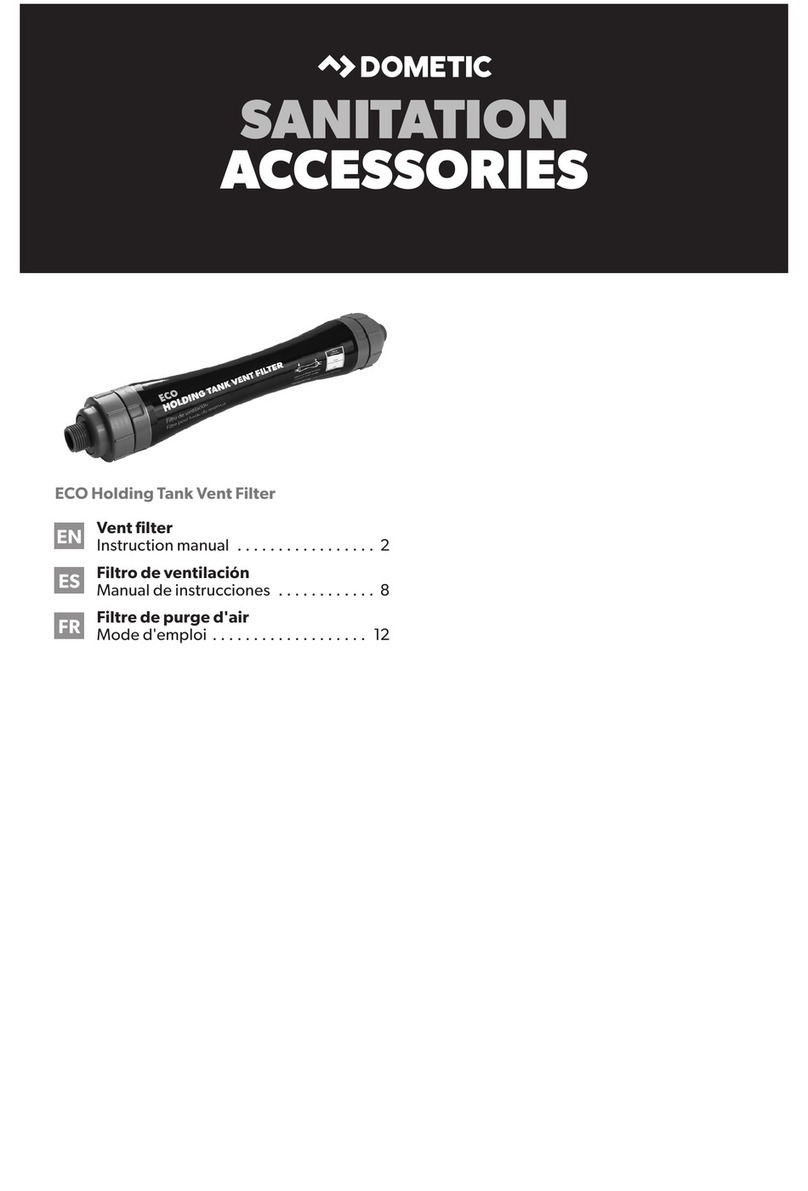
Dometic
Dometic ECO Holding Tank Vent Filter instruction manual

Philips
Philips WP3822 Micro X-Pure user manual
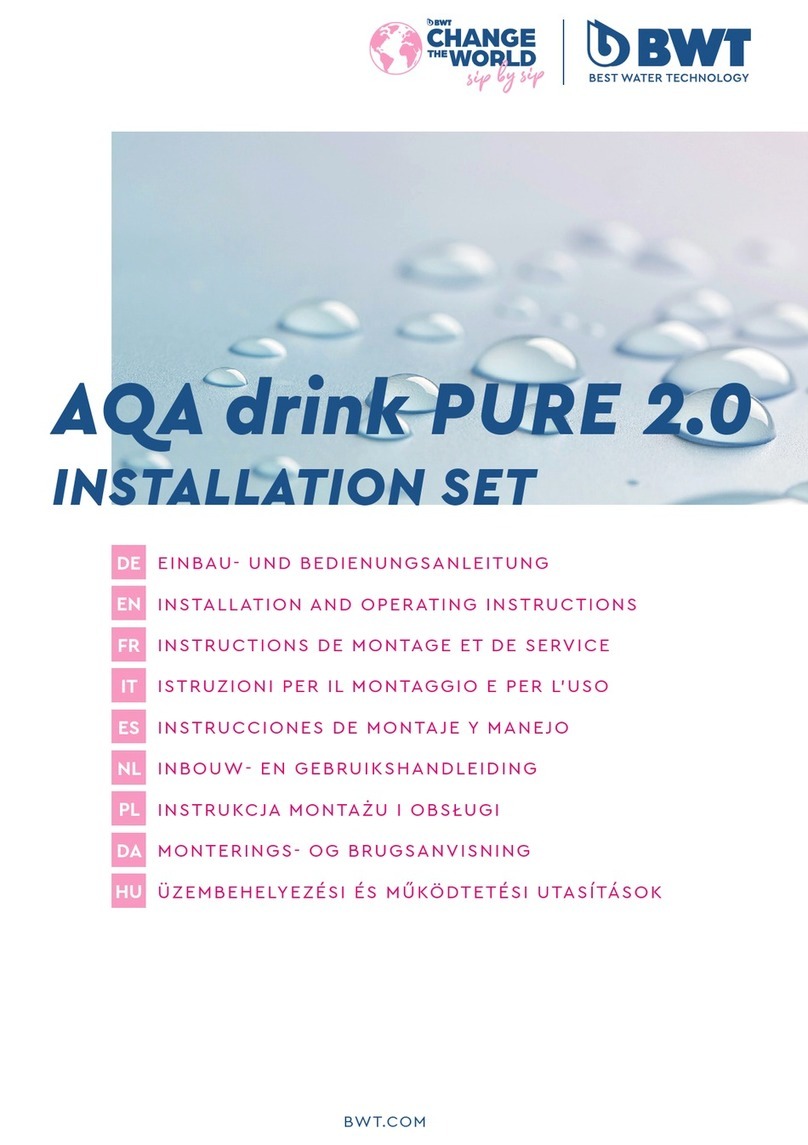
BWT
BWT AQA drink PURE 2.0 Installation and operating instructions
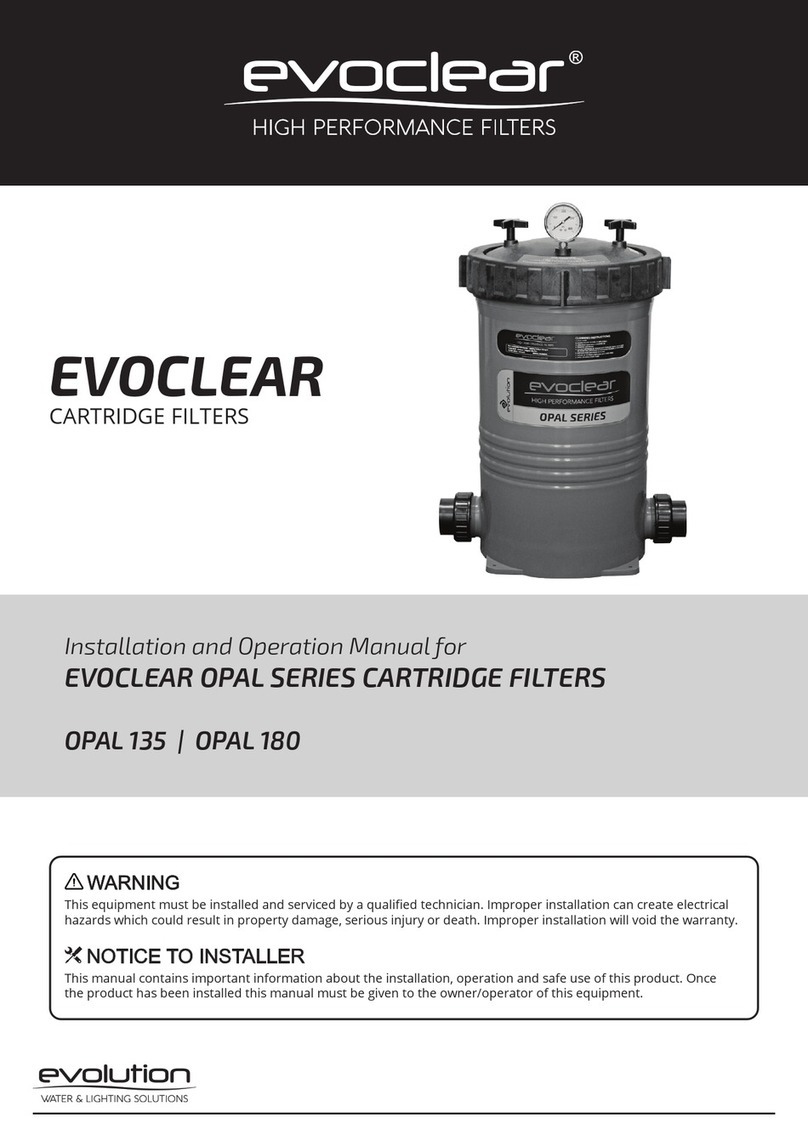
Evolution
Evolution EVOCLEAR OPAL Series Installation and operation manual

Wyckomar
Wyckomar UV-250 Installation and maintenance manual
